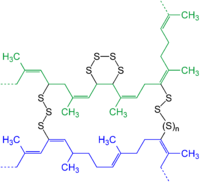
Photo from wikipedia
Abstract Reversibly interacting π-conjugated polymers of lower modulus are needed to generate intrinsically healable materials for bioelectronics applications. However, strong interchain interactions between π-conjugated polymers increases modulus and reduces flexibility… Click to show full abstract
Abstract Reversibly interacting π-conjugated polymers of lower modulus are needed to generate intrinsically healable materials for bioelectronics applications. However, strong interchain interactions between π-conjugated polymers increases modulus and reduces flexibility of networks as well as self-healing capability. Herein, to understand the impact of amine additives on the thin film moduli of hydrogen bonding π-conjugated polymer, poly[3-(6-carboxyhexyl)thiophene-2,5-diyl] (PTCOOH) was complexed with a lean (Di-2oMe) and bulky (Di-2onBu) 1,6-difunctional secondary amines. The amines interact with the PTCOOH via weak ionic interactions and/or hydrogen bonding interactions. Amine complexed PTCOOH polymer samples and PTCOOH are characterized using DSC and PXRD to correlate the assembly structure with the observed modulus. The amines acted as plasticizers and reduced the modulus of PTCOOH. Moreover, the polymer modulus decreased with increasing amine group size, indicating the importance of the amine group size. Also, the difunctional amines acted as a better plasticizer than the monofunctional amines. PXRD analysis indicates that the interchain hydrogen bonding interactions between the polymer chains play a key role in determining the moduli of thin films.
Journal Title: Polymer
Year Published: 2020
Link to full text (if available)
Share on Social Media: Sign Up to like & get
recommendations!